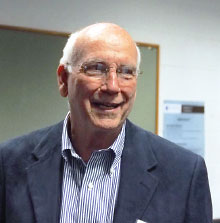A middle-aged patient who experienced severe trauma in childhood including sexual abuse by a parent dissociated from what had happened to her. After several years building trust and working on her anger in therapy, one day she finally recalled what had happened. In just two sessions, she processed it with her psychiatrist, reliving the event in vivid detail.
“I would remind the woman occasionally very benignly that I was here, so she would remember we were still in the present,” recalled Jeffery S. Smith, M.D., a clinical professor of psychiatry and leader of APA’s Caucus on Psychotherapy. “We discussed her feelings about her mother, how it felt. To my amazement after these two sessions, all of these painful memories she had were nothing but a dull ache. They were no longer terrifying, horrifying, or held sway over her life. That was a permanent change. It was a healing moment.”
In fact, working with that patient was the starting point for Smith’s career-long interest in studying change process. He said advances in neurophysiology over the past two decades have shed light on the mechanisms that trigger development of recurrent maladaptive behaviors as well as the precise conditions in psychotherapy that are needed to prompt these types of healing moments.
Austrian founder of psychoanalysis Sigmund Freud was the first to describe these types of “healing moments,” using a similar term of catharsis, Smith noted. Freud said that patients who were led to describe their painful experiences—with affect—often experienced the withering away of their pain and its related symptoms. “Freud missed one thing,” Smith said. “As a Victorian, Freud thought the doctor was an objective observer and not a participant. What he missed was the importance of his own presence in the healing moment.”
Smith said one problem with today’s many different theories of psychotherapy, from cognitive-behavioral to psychodynamic, is that they are all self-referential. “For example, if you ask a psychoanalyst to explain how therapy works, she will say she’s resolving intrapsychic conflicts between the id, ego, and superego. A cognitive-behaviorist will say he’s correcting irrational automatic thoughts,” he pointed out. Each theory is highly complicated, yet incompatible: Physicians who learn one of the many psychotherapy methods and later find it lacking must set out to master yet another, he added.
Many clinicians get mired in the complexity and give up on using a specific method of psychotherapy. “So we wind up being nice people and good listeners and engage in what’s termed ‘how ya’ doing’ therapy, where we sit down and have a nice conversation, and nothing changes for the patient. That’s not good enough,” Smith said. All forms of therapy share the same imperative: the need to create true healing moments for patients. Yet the biggest problem behind modern-day psychotherapy is a lack of understanding about how psychotherapy works, Smith said.
Evolutionary principles help explain the origin of maladaptive behavior patterns, Smith said. The mind is a survival organ that exists to predict and mitigate threats to survival as well as opportunities. Much of its work is done outside of consciousness. Most problems originate as a response to a perceived threat, he said.
For example, a woman who develops posttraumatic stress disorder after an assault receives signals of pain and danger when she thinks about the assault. So as a maladaptive behavior pattern, she begins to drink heavily. “Pretty soon she’s alcoholic and out in the middle of the night stumbling around. Guess what? She’s done nothing at all to mitigate her risk of an assault. Instead she’s killed the messenger, instead of worrying about the message.”
Psychotherapy seeks to address and treat these types of instances of recurrent maladaptive behaviors by tapping into the power of memory reconsolidation and extinction, Smith said. For clinicians, the first key is to lead patients into activation of an old response pattern and then provide disconfirming information to create memory reconsolidation and break the cycle, he said.
How does this work? Clinicians must pay close attention to a patient’s affect, which Smith defines as the bodily changes that result from conscious feelings and emotions. This may be the trigger for change, he said.
“Affect serves as a clinical indicator that the channel is open for change to take place.” For example, clinicians should pay close attention to sudden tearing up or fidgeting, he explained. “Clinicians know instinctively when something important is happening, and we clue in on that. In fact, there’s a huge body of research that shows that a patient’s display of affect during sessions correlates to a positive outcome for therapy.”
Clinicians must then seek to be a source of “disconfirming information” to the patient, by engaging in cognitive reframing, explaining, or examining the origin of a problem. This can be nonverbal, he added. “When patients perceive that you’re tuned in and really get it, and that you’re right there with them, that can be disconfirming information. This is especially true for our patients that didn’t have that kind of responsiveness from others. We do a lot of things to help people become more aware on a cognitive level, and that creates a healing moment.”
Clinicians must also pay attention to patients’ arousal regulation because when they’re too aroused, these subtle change mechanisms can’t happen, he said. “Just being there and not freaking out is one of the most powerful ways to regulate aroused people,” he said.
Supporting a patient’s motivation is also critical, he said, for example, by pointing out how much better a patient is now than two years ago or pointing out the goals of therapy. He tells his patients, “The going gets tough sometimes. It’s hard work, and you have to go against your instincts and try out new behaviors to make progress in psychotherapy.” ■

